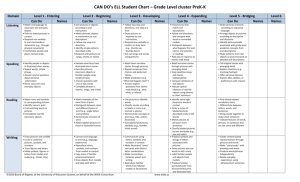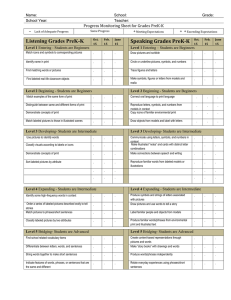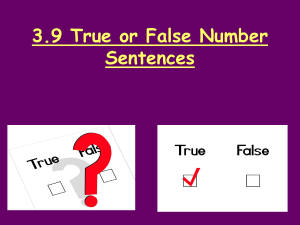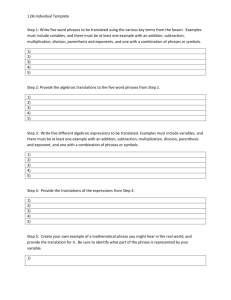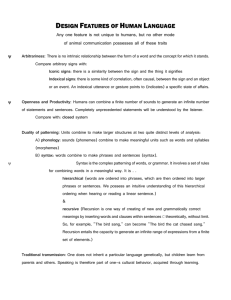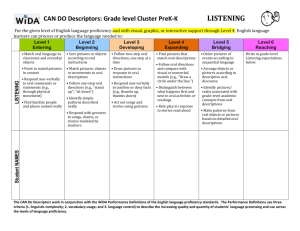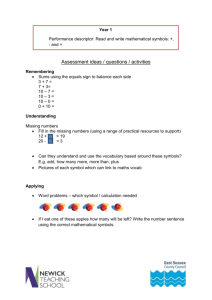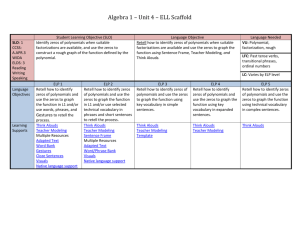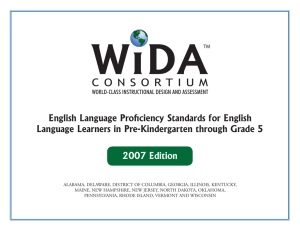ENGLISH AS A SECOND LANGUAGE (ESL) LEARNING GOALS
advertisement
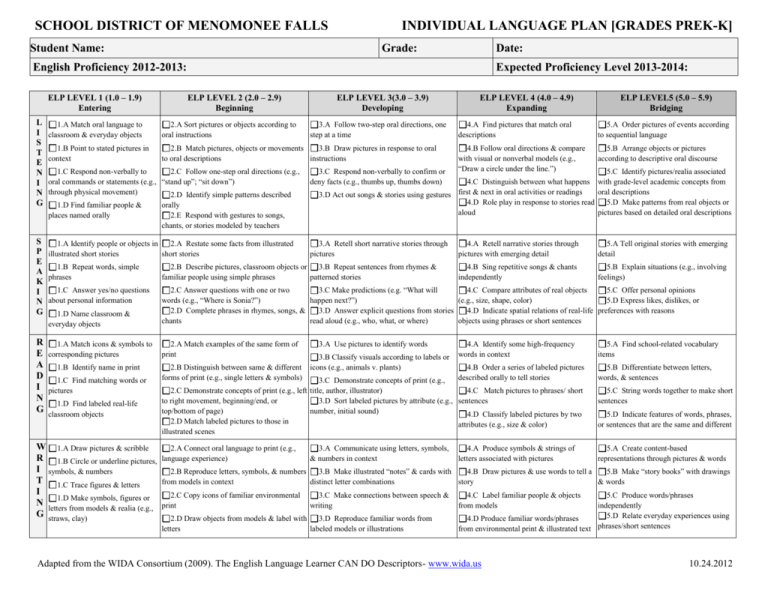
SCHOOL DISTRICT OF MENOMONEE FALLS Student Name: INDIVIDUAL LANGUAGE PLAN [GRADES PREK-K] Grade: Date: English Proficiency 2012-2013: ELP LEVEL 1 (1.0 – 1.9) Entering L I S T E N I N G Expected Proficiency Level 2013-2014: ELP LEVEL 2 (2.0 – 2.9) Beginning ELP LEVEL 3(3.0 – 3.9) Developing 1.A Match oral language to classroom & everyday objects 2.A Sort pictures or objects according to oral instructions 1.B Point to stated pictures in context 2.B Match pictures, objects or movements 3.B Draw pictures in response to oral to oral descriptions instructions 1.C Respond non-verbally to 2.C Follow one-step oral directions (e.g., oral commands or statements (e.g., “stand up”; “sit down”) through physical movement) 2.D Identify simple patterns described 1.D Find familiar people & orally places named orally 2.E Respond with gestures to songs, chants, or stories modeled by teachers 3.A Follow two-step oral directions, one step at a time 3.C Respond non-verbally to confirm or deny facts (e.g., thumbs up, thumbs down) ELP LEVEL 4 (4.0 – 4.9) Expanding ELP LEVEL5 (5.0 – 5.9) Bridging 4.A Find pictures that match oral descriptions 5.A Order pictures of events according to sequential language 4.B Follow oral directions & compare with visual or nonverbal models (e.g., “Draw a circle under the line.”) 5.B Arrange objects or pictures according to descriptive oral discourse 5.C Identify pictures/realia associated 4.C Distinguish between what happens with grade-level academic concepts from oral descriptions 3.D Act out songs & stories using gestures first & next in oral activities or readings 4.D Role play in response to stories read 5.D Make patterns from real objects or aloud pictures based on detailed oral descriptions S 1.A Identify people or objects in 2.A Restate some facts from illustrated 3.A Retell short narrative stories through 4.A Retell narrative stories through 5.A Tell original stories with emerging P illustrated short stories short stories pictures pictures with emerging detail detail E 1.B Repeat words, simple 2.B Describe pictures, classroom objects or 3.B Repeat sentences from rhymes & 4.B Sing repetitive songs & chants 5.B Explain situations (e.g., involving A phrases familiar people using simple phrases patterned stories independently feelings) K 1.C Answer yes/no questions 2.C Answer questions with one or two 3.C Make predictions (e.g. “What will 4.C Compare attributes of real objects 5.C Offer personal opinions I words (e.g., “Where is Sonia?”) happen next?”) (e.g., size, shape, color) 5.D Express likes, dislikes, or N about personal information 2.D Complete phrases in rhymes, songs, & 3.D Answer explicit questions from stories 4.D Indicate spatial relations of real-life preferences with reasons G 1.D Name classroom & everyday objects R 1.A Match icons & symbols to E corresponding pictures A 1.B Identify name in print D 1.C Find matching words or I pictures N 1.D Find labeled real-life G classroom objects chants 2.A Match examples of the same form of print 2.B Distinguish between same & different forms of print (e.g., single letters & symbols) read aloud (e.g., who, what, or where) 3.A Use pictures to identify words 3.B Classify visuals according to labels or icons (e.g., animals v. plants) objects using phrases or short sentences 4.A Identify some high-frequency words in context 4.B Order a series of labeled pictures described orally to tell stories 3.C Demonstrate concepts of print (e.g., 2.C Demonstrate concepts of print (e.g., left title, author, illustrator) 4.C Match pictures to phrases/ short to right movement, beginning/end, or 3.D Sort labeled pictures by attribute (e.g., sentences top/bottom of page) number, initial sound) 4.D Classify labeled pictures by two 2.D Match labeled pictures to those in attributes (e.g., size & color) illustrated scenes 5.A Find school-related vocabulary items 5.B Differentiate between letters, words, & sentences 5.C String words together to make short sentences 5.D Indicate features of words, phrases, or sentences that are the same and different W 1.A Draw pictures & scribble 2.A Connect oral language to print (e.g., 3.A Communicate using letters, symbols, 4.A Produce symbols & strings of 5.A Create content-based R 1.B Circle or underline pictures, language experience) & numbers in context letters associated with pictures representations through pictures & words I symbols, & numbers 2.B Reproduce letters, symbols, & numbers 3.B Make illustrated “notes” & cards with 4.B Draw pictures & use words to tell a 5.B Make “story books” with drawings T from models in context distinct letter combinations story & words 1.C Trace figures & letters I 2.C Copy icons of familiar environmental 3.C Make connections between speech & 4.C Label familiar people & objects 5.C Produce words/phrases 1.D Make symbols, figures or N writing from models independently letters from models & realia (e.g., print G straws, clay) 5.D Relate everyday experiences using 2.D Draw objects from models & label with 3.D Reproduce familiar words from 4.D Produce familiar words/phrases letters labeled models or illustrations from environmental print & illustrated text phrases/short sentences Adapted from the WIDA Consortium (2009). The English Language Learner CAN DO Descriptors- www.wida.us 10.24.2012 Strengths/Interests: Accommodations: Direct Linguistic Support in English Direct Linguistic Support in Native Language Indirect Linguistic Support-more time Program Modifications/Support: Content-Based ESL Inclusionary Support/Push-In Notes/Comments: Teacher: Date: Adapted from the WIDA Consortium (2009). The English Language Learner CAN DO Descriptors- www.wida.us 10.24.2012
